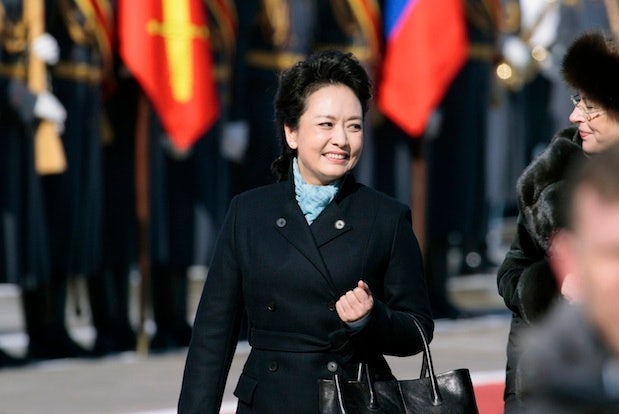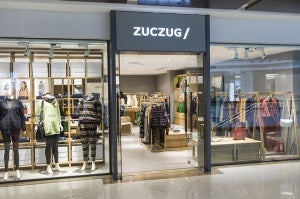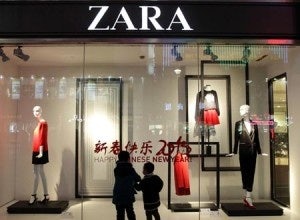
China's First Lady Peng Liyuan received worldwide attention when she was spotted wearing Chinese label Exception, a brand popular with an older generation of Chinese women.
Westerners studying the fashion preferences of Chinese women invariably report their penchant for rich ornamentation, like sequins, pearls, and embroidery, and disinterest in minimalism. The preference for cuteness is also rarely missed. Ruffles, laces, puffs, and sweet animals convey a sense of romance and playfulness that often surprise non-Asian observers. And what may at first seem a bold expression of sex appeal in the proliferance of high heels and leopard miniskirts is quickly revealed to be little more than a quest for height. Finally, observers often note a relative indifference to quality. But these observations, while relevant, do not constitute stable patterns shared by all women fashion consumers.
China’s fashion market has tripled over the past ten years, reaching $67 billion in 2012, and is expected to continue growing at an annual rate of 15 percent over the coming decade, according to a recent report by AT Kearney. And with this extraordinary economic development has come deep shifts in the emotional and cultural landscape of the country, which, in turn, have driven changes in style preferences. Once relatively monolithic, China's women’s fashion market is fragmenting along generational lines into three discernable groups: the children of the revolution, the children of reform, and the children of the boom.
Children of the Revolution#

Chinese label ZucZug, which is located in many high-end shopping districts.
Women in their late 30s and older belong to the last generation to remember growing up in a world without brand names, television, or shopping malls. The dress code was limited to uniforms, and consumers had little choice. Today, these women look for decent and comfortable fashions and steer away from excessive frivolity. They prefer formal dresses in jacquard fabrics from brands like Elegant Prosper and avoid taking risks. If they belong to the elite, they may opt for loose, Japanese-style forms offered by Chinese brands like ZucZug or Exception, affirming their status through distinctive cuts and intense colors, while staying loyal to their sense of communist frugality. There are 170 million women in China between 35 and 49 years of age, but surprisingly, they often fail to capture the attention of brands.
Children of Reform#
The post-1980s generation did not endure the same political and economic hardships that their parents did. Products of the one-child policy, they were educated according to rigorous standards, but in a context of optimism, consumerism and entrepreneurship. A transitional generation, they are loyal to their family duties and jobs, but also have their own dreams, resulting in increased fashion spending. Indeed, the post-1980s generation spend around 10 percent of their income on fashion items, according to an estimate from the Boston Consulting Group, a consulting firm. They are also the biggest online shoppers in terms of volume of sales, according to the e-commerce platform Jingdong.
Fashion mostly serves this generation’s desire to be visible in a more fiercely competitive world and to adapt to a more demanding lifestyle that combines work, leisure and social activities. This group favors brands like Only, Vero Moda, or Zara. In this segment of 25- to 35-year-olds, style preferences are evolving quickly. The influence of Korean fast fashion—romantic, sexy, decorative, and cheap—is noticeable, especially as many Chinese merchandisers are finding inspiration and products in Dongdaemun, a famous fashion market in Seoul. However, the simplicity of European fashion brands, once considered “flat,” is also seducing an increasing number of female consumers of this generation. In addition, their attention to design details and material quality is growing and increasingly influences their purchasing decisions. In the luxury market, their passion for logos is progressively fading, as some brands become over-exposed. For this group, simplicity and quality will become increasingly important in the coming years.
Children of the Boom#
Deeply rooted into technology and capitalism, these women view shopping as an entertaining and relaxing indulgence. They spend more on fashion than previous generations and their tastes fit their more impulsive personalities. They favor sporty high-street looks from Abercrombie & Fitch and Zadig et Voltaire over cuteness.
An expression of this newfound coolness is the popular Xiao Qing Xin (小清新) style, or XQX, which literally means “small and fresh”. Coming originally from indie pop music, the XQX wave now engulfs other cultural domains such as cinema, art, and fashion. It conveys a sense of self-expression, aesthetics, and simplicity, and one can expect more sophisticated inspiration and a more creative fashion mélange in this generation’s future.
For most Chinese labels, it is a challenge to stay in tune with the changing profiles of their target consumers. Established in 1989 and located in Ningbo, near Shanghai, Shanshan Group is an apparel manufacturer and fashion retailer listed in China's Top 500 Key Enterprises. Its men's classic suits, sold under the brand name FIRS, are well-known, but the Group owns 10 other brands in all market segments, including MGB, Elteno, LeTuTu, and Bellson, and manages nine licenses from French, Japanese, Italian, and Korean labels such as Le Coq Sportif, and QUA. It also runs nearly 3000 franchised shops at home and abroad. The total turnover of the group was 14.2 billion RMB in 2010.

A Zara shop with a Chinese New Year greeting.
Because of the multiple brands and international strategy of the Group, Shanshan designers and brand managers are have recently become conscious of the need to gain a better understanding of fashion branding and consumer intelligence. The recent proliferation of fashion looks have revealed their Achilles' heel; being mostly opportunistic followers, they were insufficiently prepared to anticipate style updates.
Brand managers and designers sometimes desperately look for alternative routes to follow. As Roy Zhang, the Vice General manager of KAKO, a well-established mature women fashion brand expresses it: “which brands shall we copy?”
The demand for more quality and simplicity was counterintuitive to their engrained preference for quick wins and cheap sourcing, while the request for more creative designs conflicted with their habit of copying.
Chinese brands know they have little time to adapt to the massive structural changes of the local womenswear market. The question remains, will international brands be flexible enough to meticulously monitor the relevance of their products and meet the expectations of Chinese female consumers?
Style-Vision Asia CEO Geneviève Flaven helps companies identify future business opportunities by matching their product innovations with consumer expectations in China and globally. In China, her clients include leaders of the fashion industry such as Luthai (textile), ETAM group (China), KBNE, Decoster, and other lifestyle industries as well (Sephora, Audi, and Fotile). A graduate from ESSEC in Economics and Business Administration, Flaven has worked as an expert in project management for major companies such as Hewlett Packard and CSC Peat Marwick.